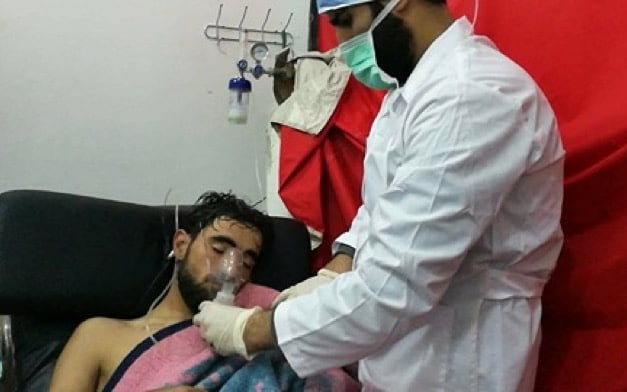A medic treats a victim of the chlorine attack on Saraqib, Idlib Province, Syria, February 4, 2018
UPDATE, APRIL 21:
The member states of the Organization for the Prohibition of Chemical Weapons have suspended some of the Assad regime’s rights and privileges, in light of the regime’s chemical attacks and withholding of chemical stocks.
In a 87-15 vote with 34 abstentions, the Conference of State Parties said the resolution was a “vital step to maintain the credibility of the Chemical Weapons Convention”, and called on Syria to come back into compliance.
The resolution expressed “deep concern” at the failure of the regime to declare fully its chemical stocks and to allow investigations of the sarin and chlorine attacks. It gave full support to OPCW investigators, who have been targeted by a protracted disinformation campaign by Russia, the regime, and their supporters.
See also UK Academics Collaborated with Russian Officials to Cover Up Assad’s War Crimes
UPDATE, 0655 GMT:
The White Helmets civil defense has welcomed the OPCW findings adding to reports that “have declared the responsibility of the Assad regime’s systematic use of chemical weapons on Syrian territory and in residential territory against Syrian civilians”.
The rescuers call for a “clear, rapid, and serious mechanism to hold the Assad regime accountable”.
Analyst Tobias Schneider notes the significance of attribution of the chlorine attack to the pro-Assad militia Tiger Forces:
Especially interesting: The Syrian formation identified by the OPCW as responsible for these CW attacks is Russia's closest partner on the ground. Its commander, Suhail Al-Hassan, travels with a Russian SOF bodyguard. Their ops room host Russian advisors who oversee the battles. https://t.co/vjEHOhVlEq
— Tobias Schneider (@tobiaschneider) April 12, 2021
ORIGINAL ENTRY: The Organisation for the Prohibition of Chemical Weapons finds “reasonable grounds” to attribute responsibility to the Assad regime for a February 2018 chlorine attack in northwest Syria.
In a 65-page report, the OPCW’s Investigation and Identification Team assessed:
At approximately 21:22 on 4 February 2018, during ongoing attacks against Saraqib, a military helicopter of the Syrian Arab Air Force under the control of the [pro-Assad militia] Tiger Forces hit eastern Saraqib by dropping at least one cylinder. The cylinder ruptured and released a toxic gas, chlorine, which dispersed over a large area affecting 12 named individuals.
The finding follows the OPCW’s formal attribution of responsibility to the Assad regime for the April 2017 sarin attack on Khan Sheikhoun, also in Idlib Province, which killed about 90 people and wounded hundreds. In its first report last April, the IIT assessed the regime’s use of sarin and chlorine on Latamineh, in neighboring Hama Province, in late March 2017, days before the Khan Sheikhoun assault.
See also UN Reaffirms — Assad Regime Carried Out Sarin and Chlorine Attacks in Northwest
About 35 chemical attacks have now been attributed to the Assad regime by the UN or OPCW. In February, the OPCW reported that the Assad regime continues to lie about its chemical facilities and stocks.
See also OPCW — Assad Regime Lied About Chemical Weapons Facilities and “Nerve Agents”
Monday’s report is based on interviews with more than 30 witnesses, analysis of samples and remnants collected in Saraqib, review of casualties and testimony of medical staff, examination of imagery, extensive consultation with experts, and topographic analysis and gas dispersion modelling.
The IIT concluded its investigation despite the obstacle of the Assad regime, which has prevented any access to sites of sarin and chlorine attacks, including Saraqib.
The town, southeast of Idlib city, was reoccupied by a Russia-regime offensive in March 2020, just before Moscow and Turkey agreed a ceasefire to halt the 11-month advance into opposition territory.
Syria Daily: Russia Pushes Back v. Turkey with Recapture of Idlib Town
The investigators rejected the regime’s claim that the attack was staged by anti-Assad forces and White Helmets rescuers through “a tunnel containing chemicals” with videos of people pretending to be victims.


“Upon impact of the cylinder on the ground, chlorine would be released from the rupture point on the cylinder body and would initially sink, as chlorine is heavier than surrounding air.”
This is straight out of Bellingcat. Chlorine is heavier than air. But convection and diffusion ensures that any gas when released has a tendency to rise.
“Discoloration of the grass at the locations of Crater 1 and Crater 2, and within their relatively close vicinity, correlates with the expected effects of chlorine release.”
This is the one “proof” offered. Of course, grass can be discoloured due to any number of factors, including fungi and other parasites.
oh…and correlation is not the same as causation.
Rastgoo,
This reply is scientifically illiterate and ignorant, so I’ll stick with the OPCW experts.
Thanks.
S.
Which part?
Chlorine rises due to convection (and diffusion): “If a heavy gas rises it perhaps could be due to convection”
https://www.standingwellback.com/an-innovative-buried-ied-detection-technology-from-1400/
Discoloration of grass due to parasites: “Though the diseases vary in severity, some can devastate your lawn with symptoms that include discoloration, poor growth, or even dead patches.”
https://www.cardinallawns.com/2016/03/identifying-lawn-diseases/
The evidence presented is not even close to being definitive. It is mostly speculative.
From the report:
“Upon careful analysis of imagery, witness statements, geolocation, metadata, and the specialists’ analysis, the IIT finds that it is indeed probable that the two craters were caused by two cylinders that, when rupturing, released chlorine at around 21:22 on 4 February 2018. Nonetheless, the information before the IIT was not sufficient to allow it to reach a conclusion to the requisite degree of certainty as to why one of the two cylinders (“Cylinder 1”) came to be located around 47 metres north of Crater 1, as shown in images from the first hours of the morning of 5 February 2018. There are simply too many variables related to location and possible movement of this cylinder after its impact, which the IIT, despite its attempts, has been unable to reconcile..”
1. The OPCW provided no chemical or medical evidence for a chlorine attack whatsoever.
2. It consulted unnamed munitions experts(who might they be, I wonder?)
3. One of the cylinders in question “landed” far from the alleged impact crater – no explanation is offered.
The excerpt is from page 26, paragraph 6.18: https://www.opcw.org/sites/default/files/documents/2021/04/s-1943-2021%28e%29.pdf